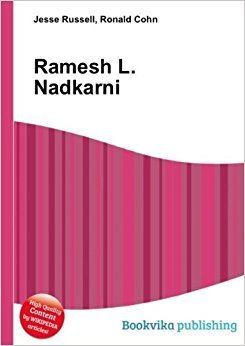Name Ramesh Nadkarni Died 1995 | Education University of Mumbai | |
 | ||
Ramesh Laxman Nadkarni (1921–1995) was a Hindustani classical music singer from Jogeshwari. Nadkarni a disciple of Aman Ali Khan had composed over 250 melodies and Ragas. He was honored for his dedicated lifelong service to classical music and was awarded a fellowship by Sursingar Sansad, Mumbai. He was part of BHENDI BAZAR GHARANA.
Contents
Ramesh was born in Mumbai in 1921 to a Chitrapur Saraswat Brahmin family from Bankikodla-Hanehalli. His father Laxman Nadkarni was an employee of the mint (coin) facility at Hyderabad. Ramesh spent his childhood in Bankikodla. After completing his middle school, he came to Mumbai to study music. His mother Uma a devotional singer inspired young Ramesh to study Hindustani music. After graduating from the University of Mumbai, he continued his music interest to earn Sangeeta Pravaeena. Nadkarni had already become a disciple of Aman Ali Khan. Ramesh was married to Sushila Balwally from Ankola.
At the age of 30, Ramesh came back to his village and served as a music teacher of the A. H. School, Bankikodla a school at his village until 1957. During his stay at Bankikodla, he taught English, and sanskrit including music at school; he kept himself busy in music programs of All India Radio (AIR), Dharwar.
At the age of 37, AIR hired Ramesh Nadkarni as a music producer in Cuttack. He spent almost two decades working for AIR at various places including Indore, Bhopal, New Delhi, Dharwar and Mumbai (1970–1981) where he retired as a director of AIR. Nadkarni wrote a biography of Mallikarjun Mansur in Kannada titled Nanna Ras Yatre.
His life and style
Nadkarni was a Music Guru of a different type. Nadkarni, though basically followed BHENDI BAZAR GHARANA style of singing was very broad and open minded. He himself was appreciative of nice points in different gharanas and always encouraged his disciples to listen to different music styles, appreciate the good points in different styles, and make efforts to imbibe them in ones style of singing. He maintained that this approach of consciously imbibing the best that is available in the vast field of music would make one a more enriched and enlightened musician than being with a particular traditional style.
Nadkarni was a devotee of Bhagawan Nityananda and wrote a biography of Bhagawan Nityananda in Kannada and other languages. Ramesh Nadkarni was simple, generous human being; he was a performer, producer, director and a teacher of classical music. Though he had modest academic qualifications, he was so well read that, apart from music, he could authoritatively speak on diverse subjects in English, hindi, urdu and kannada literature.
Nadkarni was handicapped with Asthma but he knew how to get his own way. He dedicated his life for writing and singing Ragas and melodies and died on September 7, 1995; he was 74. Nadkarni is survived by his wife, two children who live in Mumbai and disciples like Sairam Iyer, Sakuntala Narsimhan, Devendra Murdeshwar, Mahendra Kapoor and Shaila Piplapure.
Work
Raga – Jogkauns
This composition asks one to be conveys the message of what contains the how the thought basically is devotional one, in nature brings out the philosophy of
(Wording of the composition in Hindi language is as below).
HE MAAN KAHE KARAT VICHAR, DWANDWA TYAJA, SUMIR AMAR NIT NIRAKAR
CHINTANA KAR NISHCHINTA CHITTA DHAR HAR KAR PAKARAT KAR NIRADHAR KO.
The meaning in English of this composition is somewhat as below.
Oh, you mind ! why do you always steeped in thoughts. Do not engage yourself in the duality of thoughts. Give up this duality. I ask you to listen to the inner voice of God in you. Always think of God with a relaxed mind, and, as you very well know, He always extends His supportive hand to those, who need it.
Raga – Bairagi Bhairav
This composition can be interpreted in two different ways.
(Wording of the composition in Hindi is as below.)
SUR SURAS SADHALE RASIK GAON. SABAD SALONE LAYA TAAL SURANSO.
AMAR KAHAT HAI NIRAKH SANS KO AUR LAYATARANG RAS BARASE.
The meaning in English of this composition is somewhat as below.
You should practice to sing the correct notes and sing them melodiously. The words of your composition should be beautiful and well-interwoven in the rhythmic patters. I (AMAR) say that, while singing, you must constantly watch your breath. If you follow these, you would present ripples of good and enjoyable music.
Nadakarni has contributed a lot to Kannada light music as well. Kannada poet B.A. Sanadi recollects how Nadakarni set tunes to Kannada lyrics being in Mumbai. His compositions are very melodious and quite different in approach. Today's Kannada Light Music fraternity doesn't take note of his work.
